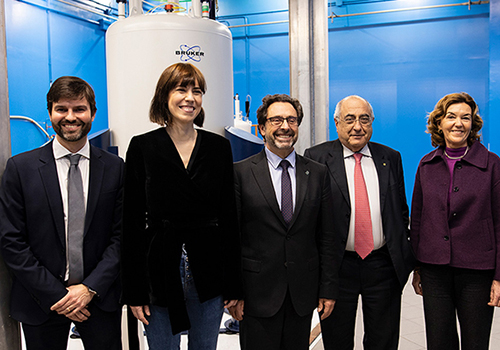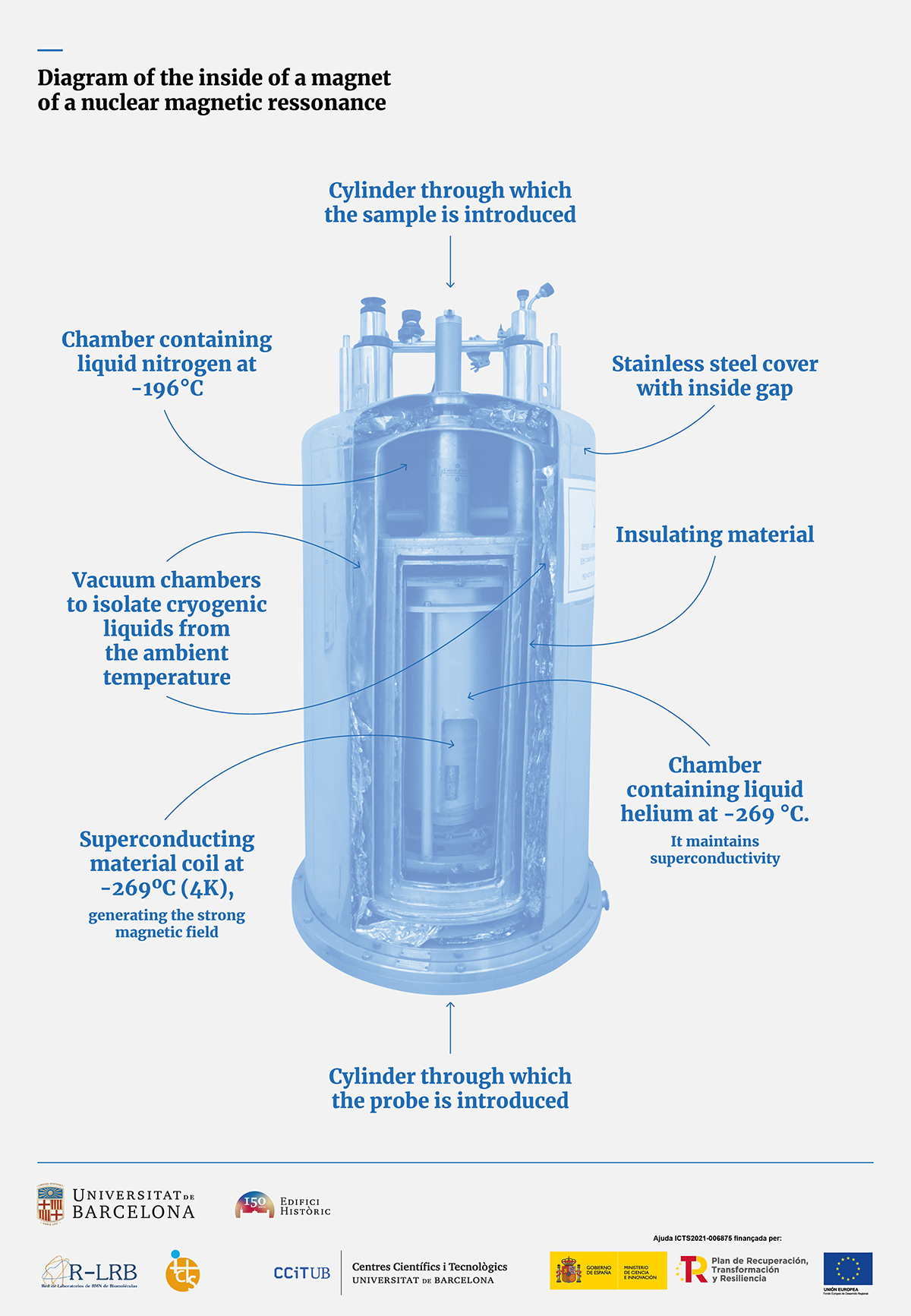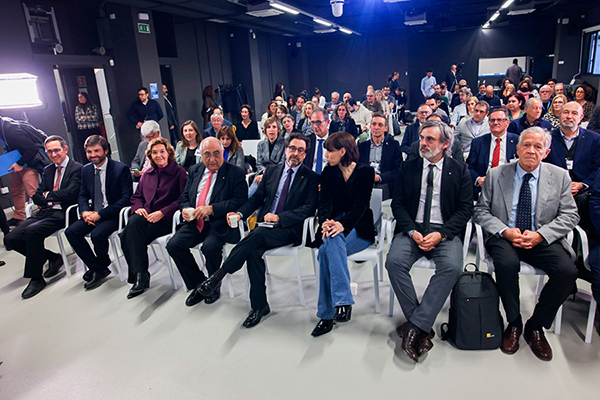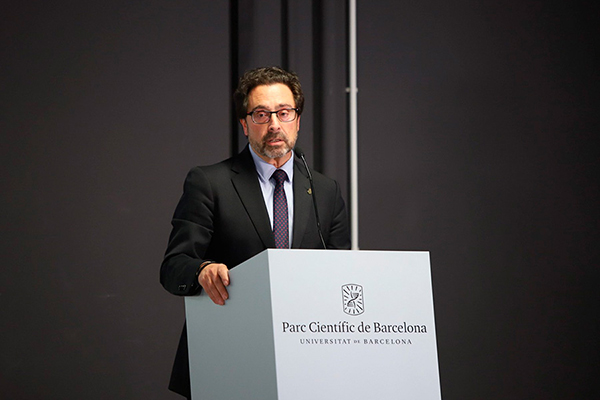A unique infrastructure

The minister for Science and Innovation, Diana Morant, the minister for Research and Universities, Joaquin Nadal, and the rector of the UB, Joan Guàrdia, inaugurated the first high-field nuclear magnetic resonance device in Spain. The new NMR equipment creates a magnetic field, 500,000 times more intense than the terrestrial magnetic field, which allows the molecule hydrogen atoms to send a signal at a frequency of 1 GHz (1 billion revolutions per second). With a cost of 8.9 million euros, the equipment has been funded thanks to a grant from the Spanish Ministry of Science and Innovation and the Next Generation EU funds within the recovery, transformation and resilience program. The equipment is in the UB’s Scientific and Technological Centres’ NMR laboratory, a space specially designed for equipments with large magnetic fields in the Barcelona Science Park. The equipment is part of the Instal·lació Científica Tècnica Singular (ICTS) of the Biomolecule NMR Laboratory Network (R-LRB), which was launched in Barcelona in order to provide a service to the scientific community in Spain.

The minister for Science and Innovation, Diana Morant, the minister for Research and Universities, Joaquin Nadal, and the rector of the UB, Joan Guàrdia, inaugurated the first high-field nuclear magnetic resonance device in Spain. The new NMR equipment creates a magnetic field, 500,000 times more intense than the terrestrial magnetic field, which allows the molecule hydrogen atoms to send a signal at a frequency of 1 GHz (1 billion revolutions per second). With a cost of 8.9 million euros, the equipment has been funded thanks to a grant from the Spanish Ministry of Science and Innovation and the Next Generation EU funds within the recovery, transformation and resilience program. The equipment is in the UB’s Scientific and Technological Centres’ NMR laboratory, a space specially designed for equipments with large magnetic fields in the Barcelona Science Park. The equipment is part of the Instal·lació Científica Tècnica Singular (ICTS) of the Biomolecule NMR Laboratory Network (R-LRB), which was launched in Barcelona in order to provide a service to the scientific community in Spain.
The nuclear magnetic resonance (NMR) is one of the most powerful techniques for obtaining atomic-scale structural and dynamic information of complex molecules, including the interactions and alterations that take place in vivo. This technology, which is applied in research areas such as chemistry, biology and biomedicine, is decisive for studying the features of molecules, identifying the active conformations of a compound, detecting the interactions between drugs and receptors, identifying new therapeutic targets and designing drugs to fight diseases.
The minister for Science and Innovation, Diana Morant, highlighted that “this tool provides us with hope and its technology is decisive, for instance, to design precision drugs that will help us fight illnesses such as cancer, a global challenge that affects us all from a short distance”. The minister also noted that this tool materializes the new way in which “the Government is guiding and prioritizing the innovation and scientific policies, at the service of society’s needs”.
Minister Nadal welcomed the launch of the new equipment, “which is in line with the Government’s policy in drawing a scientific arch of centres and infrastructures over the area, new and renewed pieces and an authentic scientific Lego that enables doubling the capacities of the Catalan knowledge system to advance in research”.
The rector of the UB, Joan Guàrdia, said that the “Diagonal Campus is destined to become the most powerful healthcare center in southern Europe”. “The CCiTUB and PCB research infrastructures, the scientific and teaching excellence of the UB and the future expansion of the Clinic Campus in the area make a triple helix that will mark the progress and knowledge of the country for several generations”, noted the rector.
The first one in Spain and in Europe.
This is the first equipment in Europe and the second worldwide —following Japan— that uses high-temperature superconductors to create magnetic fields in a 1 GHz NMR tool. To solve the problems coming from the resistance created by the generation of ultra-intense magnetic fields through the high-intensity electric current, the new equipment will use coils designed with superconducting materials.
Under certain conditions, superconducting coils cannot offer resistance to the passage of the electric current (zero resistance), and allow the permanent circulation of electric flow once it is disconnected from the electrical network. The Institute of Materials Sciences of Barcelona (ICMAB-CSIC) has played an essential role in the development of the high-temperature superconductors installed in the NMR. “Therefore, the new high-temperature superconductors keep their zero resistance at higher temperatures, they accept intense currents and are maintained as superconductors in very high magnetic fields”, notes Miquel Pons, scientific coordinator of the Barcelona node at ICTS -LRB.
In order to ensure its sustainability, the UB has bought, with the grant, a system of helium reliquefaction that allows the gas to be liquefied again, and this reduces the use of a very limited resource and it increases the viability regarding potential supply problems or future price raises. The project includes the development of a data management system that will include artificial intelligence systems and will enable the researchers to make sure that the data are easy to find and accessible, interoperable and reusable, according to the FAIR principles of best practices in the management of scientific data.
With the installation of the 1 Ghz NMR device, the UB is once again a pioneer in state magnetic resonance equipment for other services. In 1999, the CCiTUB acquired a high-field NMR equipment —the first 800 MHz equipment in Spain— which was the most powerful at that time.
“The 1 Ghz NMR device has a 25% higher magnetic field than the previous most powerful equipment but it improves the sensitivity for the study of proteins by a factor of 2.5 times, which translates into a time saving of 6.26 times. That is, an experiment that would require a week using the 800 MHz equipment will be now solved in a day using the new device”, says Miquel Pons.
Building the most powerful healthcare hub in southern Europe
The incorporation of the new 1.0 Ghz NMR device at the CCiTUB “will promote strategical research lines in Europe and around the world and will provide new synergies between research networks”, notes Juan Fran Sangüesa, director of CCiTUB. “It will have a direct impact on the industrial tissue in Catalonia, specially in key sectors such as the biomedical and the biotechnological, fields where it can be a strategic element to maintain the competitiveness. Moreover, in the academic field, the team will contribute to attracting talent and offering quality training to our students”, he says.
The device was installed in the UB Barcelona Scientific Park, one of the distinguished ecosystems in Europe regarding research, technological transfer and innovation, with more than 100,000m² and 3,000 professionals from different institutions mainly working in the healthcare sector. Currently, the PCB has almost all 31,500 m² of scientific space occupied. The PCB is now working on fitting out the CUB building, initially conceived as an auditorium, in order to provide an additional 1,900 m² of non-experimental laboratory space and make it available to the life sciences sector.
1 Ghz MRI: cutting-edge technology for applications
The new technology will make it possible to boost research in different fields of application, such as the use of disordered proteins as therapeutic targets, drugs of biotechnological origin, proteins related to the development of cancer, or the characterization of anticoagulants for the design of vaccines, etc.
The NMR technique is based on the magnetic properties of atomic nuclei. Specifically, NMR can detect and analyze the environment of atomic nuclei that rotate and orient their nuclear spin under a strong external magnetic field. The set of signals from individual atoms is the NMR spectrum. The very high-field nuclear magnetic resonance device contains a state-of-the-art hybrid magnet that includes a new high-temperature superconductor. In this way, it is possible to create a magnetic field sufficient to reach a frequency of 1 GHz. The ability to distinguish each atom within a molecule depends on the power of the magnet.
"The NMR uses very powerful magnets; the ability to distinguish each atom within a molecule depends on the power of the magnet. With such high magnetic fields, there is a significant gain in resolution and sensitivity, as well as a significant decrease in data acquisition time. This will be a great boost for the structural and dynamic study of complex biomolecules", concludes Miquel Pons.
See photos of the event on Flickr.
Multimedia gallery

Diagram of the inside of a magnet of a nuclear magnetic ressonance.

During the event.

